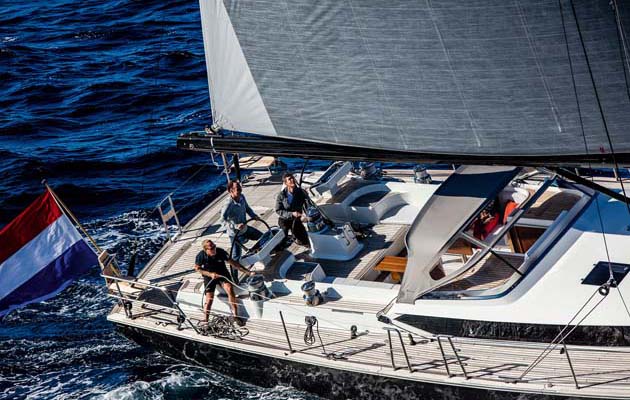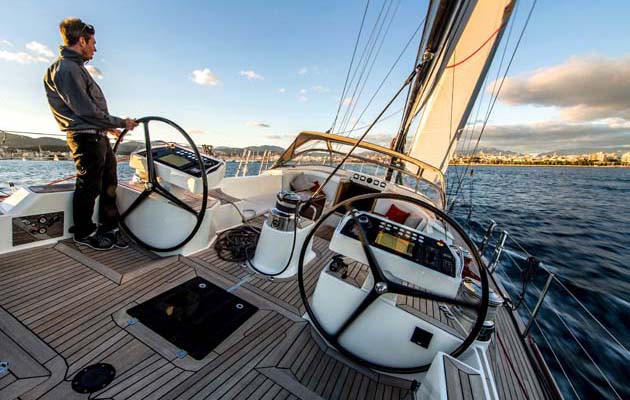Some yachts develop character, while others have it built in. Toby hodges went in search of heart and soul
The wind continued to increase, into the mid-20s, bringing short, sharp waves with it as we headed offshore past the lighthouse. There was little we could now do, other than try and keep her sailing and looking good. It was time to speak to Jesús.
Contest wanted brochure photos from a helicopter and we wanted to test sail the boat so we had spent the previous evening planning it all to a tee. The problem is that the boat needs to look just so for the pictures, even if a little artificially at times.
The upside was that once the photos were done, we would have a long day on the boat sailing, anchoring and living aboard in a variety of conditions, plus some resultant fantastic pictures. But of course, the wind pays no heed to plans and schedules.
Once the call was made to Mallorcan photographer Jesús Renedo confirming that we were in the pre-arranged place and sailing at full speed, the chopper would take off and be overhead in minutes. We needed to be on a good angle with the kite set.
Knowing it all had to work like clockwork before the allotted helicopter slot elapsed heightened the nerves on board. The wind was forecast to start relatively light and pick up during the day – hence it did the opposite. By 1000 Force 6 to 7 gusts were barrelling down the cliff edges nearby.
Thundering along under the big red asymmetric at 10-12 knots, preparing for the noisy imminent arrival overhead, I took the helm and tried to point her up to get some more sun on the deck for the pictures. In a 25-knot gust, we eased the main too little, and a dramatic flapping of sails accompanied our rapid heel change – evincing some rather concerned looks from the model in the cockpit.
Keeping this over-canvassed yacht’s bow firmly down would be the key to a successful shoot in these conditions.
Packing too much punch?
We dropped the kite and headed up on to a close reach, until the helicopter departed and boat test duties commenced. Gusts of up to 30 knots rolled over the decks as we headed upwind, so to ease the load on the helm, we bent a reef into the vertically battened in-mast mainsail and furled some genoa.

With full canvas up in over 20 knots, it’s testosterone time – it’s a workout on the wheel – and you need a crewmember attentively manning the mainsheet to maintain cooperation between helm and vessel. Most cruising sailors will welcome the communication from the Contest’s rudder: it lets you know when she’s pushed.
I have become accustomed to twin rudder set-ups on yachts of this size now, yachts where the power is not communicated as directly as the single blade set up. A glance at the size of the winches (size 88 for the primaries) and deck gear is a telling reminder of the loads she generates and the need to respect these loads.
It should also be noted that the test boat had the full extra performance options of a Hall Spars carbon rig and SCR rigging, plus 3Di sails.
As the wind began to ease later in the day, we were able to set full sail again in 15 knots gusting to 24 knots over flat water. During that afternoon and evening sail, the boat felt alive.
With the correct sail set-up you can really drive her hard and point her up through the gusts like a performance yacht (upwind at eight to eight-and-a-half knots). It became clear that the 67CS has the legs and consistent speed to get places quickly.

“It’s a Judel/Vrolijk design, so one level higher in performance to past models,” says CEO Arjen Conijn. “We worked very hard to combine this with the safety and comfort that are the cornerstones of our fleet.
“In past days north European yards focused on all-weather boats. But now, with more clients in the Med, we need to be able to sail in light winds too. It’s not just about surviving on the boat.”
Compare with the Yachting World review of the Contest 42.
I have seen the 67CS sailing in five knots of wind off Cannes, so I know that she’s a slippery design. Indeed, as we headed back to Palma at the end of the test day, the evening breeze had dropped to ten to 15 knots and the Contest really excelled.
With the Code 0 set, we reached along at nine and a half to ten knots, up to 10.5 knots in the gusts, the speeds as consistent as they were impressive.
The question is whether Contest has given her too much performance for an ocean cruising yacht? I don’t think so.

She has almost exactly the same sail area-to-displacement and displacement-to-length ratios as the new Oyster 675. Granted, these may be slightly more performance oriented figures than past bluewater models from these yards, but I’d rather a boat be able to sail in light airs.
Of course, the test boat had upgraded rig and sails, which certainly helped get the most out of the breeze, but the key is to make the boat easy to tame and manage. And that’s where the push-button furling systems and deck layout comes into play.
The cockpit and deck layout of the Contest, particularly around the helm consoles, is excellent. For a centre cockpit yacht, it’s a very practical set-up with good visibility forward from the helms.
The ability to stand outside the coamings when helming, or sit straddling them, and see along the windward or leeward decks to the telltales and beyond, will rate highly with active sailors. And she’s a yacht you’ll want to stand and helm for long periods – there are no helm seats. Angled foot wells provide the ideal support while standing.
The central mainsheet and outboard primary winches are mounted well within reach of the helm. “This is the base from which anything can work – from there you can orient it more towards short-handed or performance,” says Conijn.
For a yacht with such clean lines, I would like to have seen stowage designed in for the sheet tails. Also, the test boat had vertically mounted winches on the base of the mast.
With little space between the winch and jammer however, it was a slow process to hoist the gennaker. For jobs that may involve going aloft, I would opt for powered winches on the deck, each side of the mast.
Barring the fancy sails and rigging, Conijn maintains that the deck layout itself is reasonably standard and that it’s the interior that is highly customised. And what an interior this yacht has.



